Analysis of Spatiotemporal Patterns of Undernutrition among Children below Five Years of Age in Uganda
Abstract
:1. Introduction
2. Materials and Methods
2.1. The Study Area
2.2. Data and Data Sources
2.3. Methods of Data Analysis
3. The Moran’s I Statistic for Global Spatial Autocorrelation
The Getis-Ord (Gi*) Statistic for Hot Spot Analysis
4. Results
4.1. The Prevalence of Undernutrition among Childrem below 5 Years of Age in Uganda Based on the CIAF
4.2. Spatial Variations of Undernutrition among Children below 5 Years of Age in Uganda
4.3. Cluster and Hot-Spots Analysis
4.4. Geographically Weighted Regression Analysis

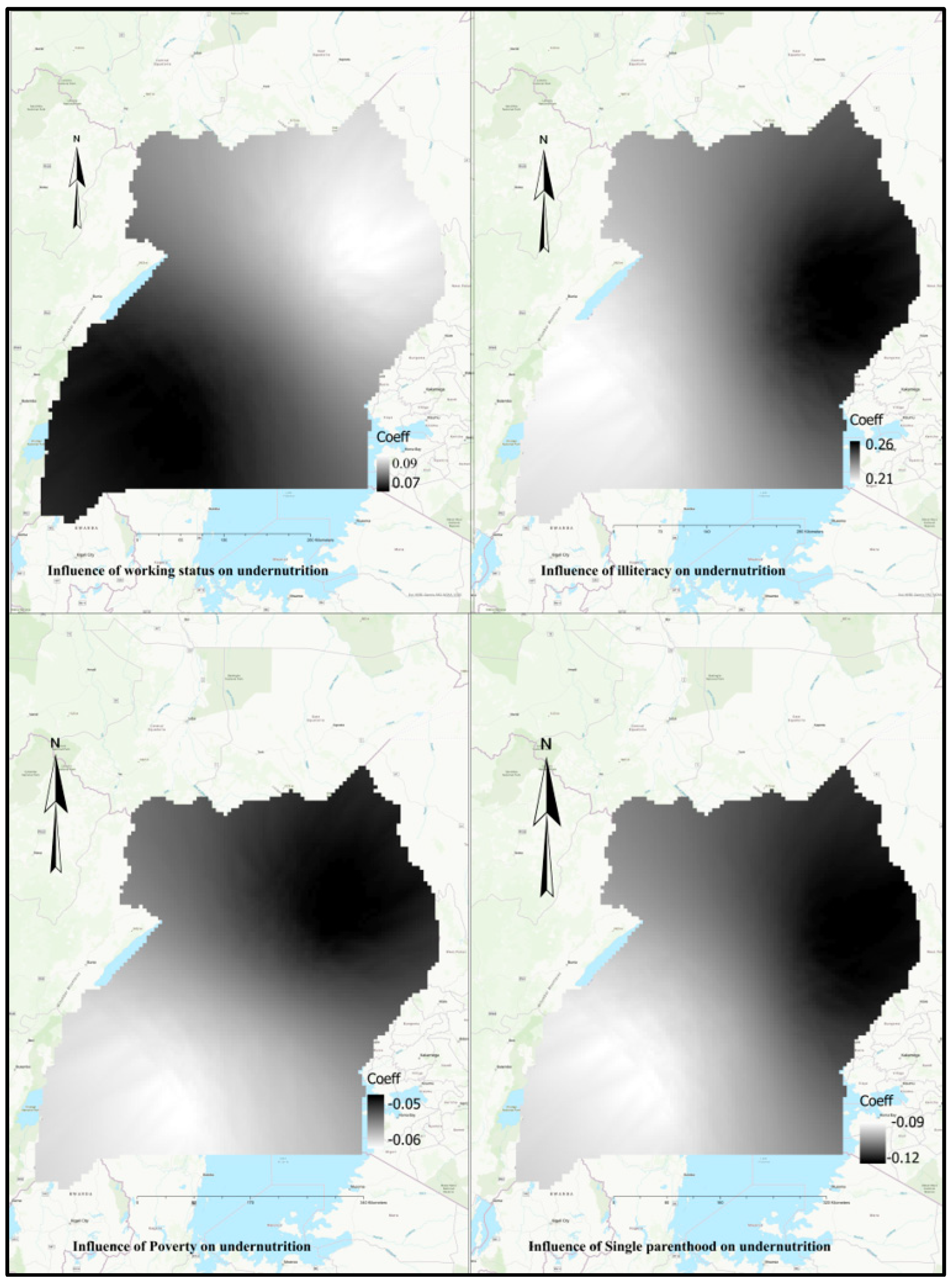
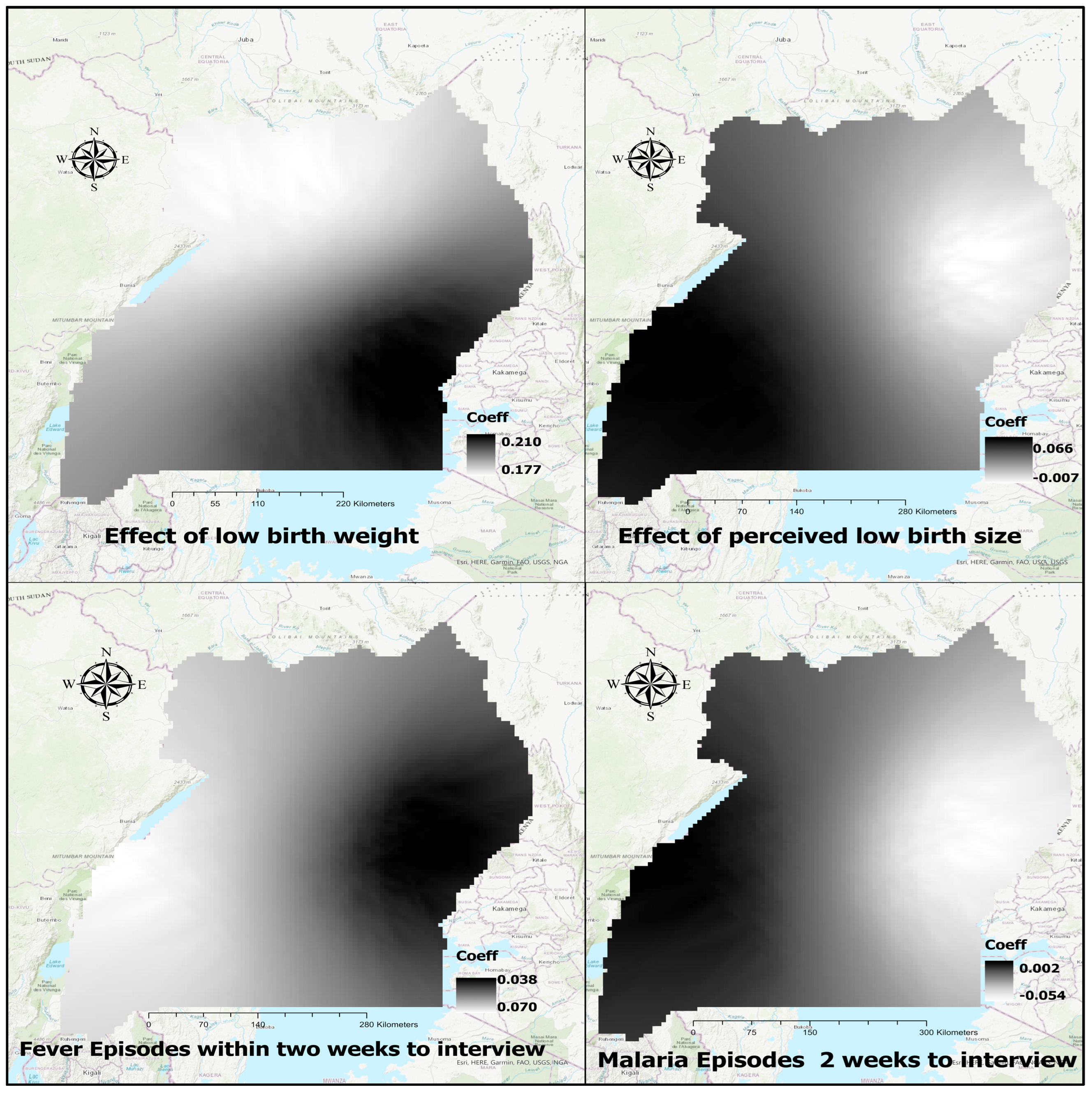
5. Discussion of the Results
6. Conclusions
Author Contributions
Funding
Institutional Review Board Statement
Informed Consent Statement
Data Availability Statement
Acknowledgments
Conflicts of Interest
References
- Jith, J.R.; Bedamatta, R. Child Undernutrition in the States of India: An Analysis Based on Change in Composite Index of Anthropometric Failure from 2006 to 2016. Rev. Dev. Change 2021, 26, 104–126. [Google Scholar] [CrossRef]
- Boah, M.; Azupogo, F.; Amporfro, D.A.; Abada, L.A. The epidemiology of undernutrition and its determinants in children under five years in Ghana. PLoS ONE 2019, 14, e0219665. [Google Scholar] [CrossRef]
- Luzingu, J.K.; Stroupe, N.; Alaofe, H.; Jacobs, E.; Ernst, K. Risk factors associated with under-five stunting, wasting, and underweight in four provinces of the Democratic Republic of Congo: Analysis of the ASSP project baseline data. BMC Public Health 2022, 22, 2422. [Google Scholar] [CrossRef] [PubMed]
- Vaivada, T.; Akseer, N.; Akseer, S.; Somaskandan, A.; Stefopulos, M.; Bhutta, Z.A. Stunting in childhood: An overview of global burden, trends, determinants, and drivers of decline. Am. J. Clin. Nutr. 2020, 112, 777S–791S. [Google Scholar] [CrossRef]
- World Health Organization. Global Nutrition Targets 2025: Stunting Policy Brief; World Health Organization: Geneva, Switzerland, 2014. [Google Scholar]
- Rah, J.H.; Cronin, A.A.; Badgaiyan, B.; Aguayo, V.M.; Coates, S.; Ahmed, S. Household sanitation and personal hygiene practices are associated with child stunting in rural India: A cross-sectional analysis of surveys. BMJ Open 2015, 5, e005180. [Google Scholar] [CrossRef]
- Soekatri, M.Y.E.; Sandjaja, S.; Syauqy, A. Stunting was associated with reported morbidity, parental education and socioeconomic status in 0.5–12-year-old Indonesian children. Int. J. Environ. Res. Public Health 2020, 17, 6204. [Google Scholar] [CrossRef]
- Thompson, A.L. Greater male vulnerability to stunting? Evaluating sex differences in growth, pathways and biocultural mechanisms. Ann. Hum. Biol. 2021, 48, 466–473. [Google Scholar] [CrossRef] [PubMed]
- Roba, A.A.; Assefa, N.; Dessie, Y.; Tolera, A.; Teji, K.; Elena, H.; Bliznashka, L.; Fawzi, W. Prevalence and determinants of concurrent wasting and stunting and other indicators of malnutrition among children 6–59 months old in Kersa, Ethiopia. Matern. Child Nutr. 2021, 17, e13172. [Google Scholar] [CrossRef]
- Prendergast, A.J.; Humphrey, J.H. The stunting syndrome in developing countries. Paediatr. Int. Child Health 2014, 34, 250–265. [Google Scholar] [CrossRef]
- Darteh, E.K.M.; Acquah, E.; Kumi-Kyereme, A. Correlates of stunting among children in Ghana. BMC Public Health 2014, 14, 504. [Google Scholar] [CrossRef]
- Vonaesch, P.; Tondeur, L.; Breurec, S.; Bata, P.; Nguyen, L.B.L.; Frank, T.; Farra, A.; Rafaï, C.; Giles-Vernick, T.; Gody, J.C. Factors associated with stunting in healthy children aged 5 years and less living in Bangui (RCA). PLoS ONE 2017, 12, e0182363. [Google Scholar] [CrossRef] [PubMed]
- Shrestha, M.L.; Perry, K.E.; Thapa, B.; Adhikari, R.P.; Weissman, A. Malnutrition matters: Association of stunting and underweight with early childhood development indicators in Nepal. Matern. Child Nutr. 2022, 18, e13321. [Google Scholar] [CrossRef] [PubMed]
- Kirolos, A.; Blacow, R.M.; Parajuli, A.; Welton, N.J.; Khanna, A.; Allen, S.J.; McAllister, D.A.; Campbell, H.; Nair, H. The impact of childhood malnutrition on mortality from pneumonia: A systematic review and network meta-analysis. BMJ Glob. Health 2021, 6, e007411. [Google Scholar] [CrossRef] [PubMed]
- Gribble, J.N.; Murray, N.J.; Menotti, E.P. Reconsidering childhood undernutrition: Can birth spacing make a difference? An analysis of the 2002-2003 El Salvador National Family Health Survey. Matern. Child Nutr. 2009, 5, 49–63. [Google Scholar] [CrossRef]
- Khan, A.Y.; Fatima, K.; Ali, M. Sanitation ladder and undernutrition among under-five children in Pakistan. Environ. Sci. Pollut. Res. Int. 2021, 28, 38749–38763. [Google Scholar] [CrossRef]
- United Nations. Department of Economic and Social Affairs, Sustainable Development Goals; United Nations Department of Economic and Social Affairs: New York, NY, USA, 2015. [Google Scholar]
- Alemu, Z.A.; Ahmed, A.A.; Yalew, A.W.; Birhanu, B.S. Non random distribution of child undernutrition in Ethiopia: Spatial analysis from the 2011 Ethiopia demographic and health survey. Int. J. Equity Health 2016, 15, 198. [Google Scholar] [CrossRef]
- Spray, A.L.; Eddy, B.; Hipp, J.A.; Iannotti, L. Spatial analysis of undernutrition of children in léogâne commune, haiti. Food Nutr. Bull. 2013, 34, 444–461. [Google Scholar] [CrossRef]
- Maniragaba, V.N.; Atuhaire, L.K.; Rutayisire, P.C. Undernutrition among the children below five years of age in Uganda: A spatial analysis approach. BMC Public Health 2023, 23, 390. [Google Scholar] [CrossRef]
- Marie-Pierre de Bellefon, J.-M.F. Geographically Weighted Regression. In Handbook of Spatial Analysis: Theory and Application with R; Insee: Paris, France, 2018. [Google Scholar]
- UBOS. Uganda Demographic and Health Survey 2016. UDHS. 2016, p. 625. Available online: https://www.dhsprogram.com/ (accessed on 14 May 2023).
- Tesema, A.K.; Liyew, A.M.; Alem, A.Z.; Yeshaw, Y.; Tesema, G.A.; Teshale, A.B. Spatial distribution and determinants of undernutrition among reproductive age women of Ethiopia: A multilevel analysis. PLoS ONE 2021, 16, e0257664. [Google Scholar] [CrossRef]
- Tamir, T.T.; Techane, M.A.; Dessie, M.T.; Atalell, K.A. Applied nutritional investigation spatial variation and determinants of stunting among children aged less than 5 y in Ethiopia: A spatial and multilevel analysis of Ethiopian Demographic and Health Survey 2019. Nutrition 2022, 103–104, 111786. [Google Scholar] [CrossRef]
- Amir-ud-Din, R.; Fawad, S.; Naz, L.; Zafar, S.; Kumar, R.; Pongpanich, S. Nutritional inequalities among under-five children: A geospatial analysis of hotspots and cold spots in 73 low- and middle-income countries. Int. J. Equity Health 2022, 21, 135. [Google Scholar] [CrossRef] [PubMed]
- Khan, J.; Mohanty, S.K. Spatial heterogeneity and correlates of child malnutrition in districts of India. BMC Public Health 2018, 18, 1027. [Google Scholar] [CrossRef] [PubMed]
- Amusa, L.B.; Yahya, W.B.; Bengesai, A.V. Spatial variations and determinants of malnutrition among under-five children in Nigeria: A population-based cross-sectional study. PLoS ONE 2023, 18, e0284270. [Google Scholar] [CrossRef] [PubMed]
- Muche, A.; Melaku, M.S.; Amsalu, E.T.; Adane, M. Using geographically weighted regression analysis to cluster under-nutrition and its predictors among under-five children in Ethiopia: Evidence from demographic and health survey. PLoS ONE 2021, 16, e0248156. [Google Scholar] [CrossRef]
- Melaku, M.S.; Aemro, A.; Aychiluhm, S.B.; Muche, A.; Bizuneh, G.K.; Kebede, S.D. Geographical variation and predictors of zero utilization for a standard maternal continuum of care among women in Ethiopia: A spatial and geographically weighted regression analysis. BMC Pregnancy Childbirth 2022, 22, 76. [Google Scholar] [CrossRef] [PubMed]
- Anismuslim, M.; Pramoedyo, H.; Andarini, S.; Sudarto. Modeling of Risk Factors of Childhood Stunting Cases in Malang Regency using Geographically Weighted Regression (GWR). Open Public Health J. 2023, 16, e187494452304120. [Google Scholar] [CrossRef]
- Mtambo, O.P.L. Spatio-Temporal Analysis of Childhood Malnutrition in Republic of Congo. Int. J. Stat. Appl. 2018, 8, 153–166. [Google Scholar]
- Sartorius, B.; Sartorius, K.; Green, R.; Lutge, E.; Scheelbeek, P.; Tanser, F.; Dangour, A.D.; Slotow, R. Spatial-temporal trends and risk factors for undernutrition and obesity among children (<5 years) in South Africa, 2008–2017: Findings from a nationally representative longitudinal panel survey. BMJ Open 2020, 10, e034476. [Google Scholar] [CrossRef]
- Liu, J.; Fritz, S.; van Wesenbeeck, C.F.A.; Fuchs, M.; You, L.; Michael Obersteiner, H.Y. A spatially explicit assessment of current and future hotspots of hunger in Sub-Saharan Africa in the context of global change. Glob. Planet. Change 2008, 64, 222–235. [Google Scholar] [CrossRef]
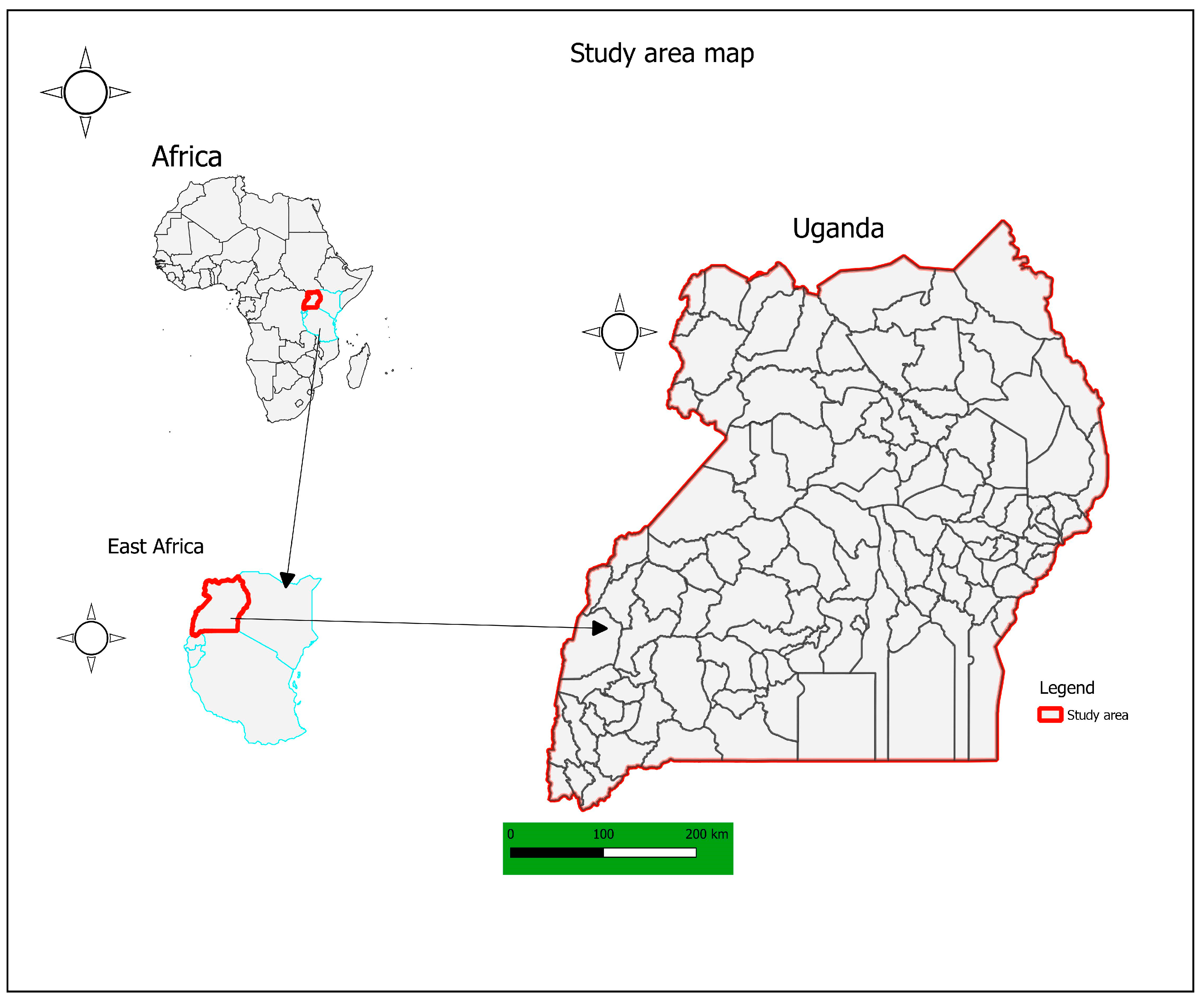
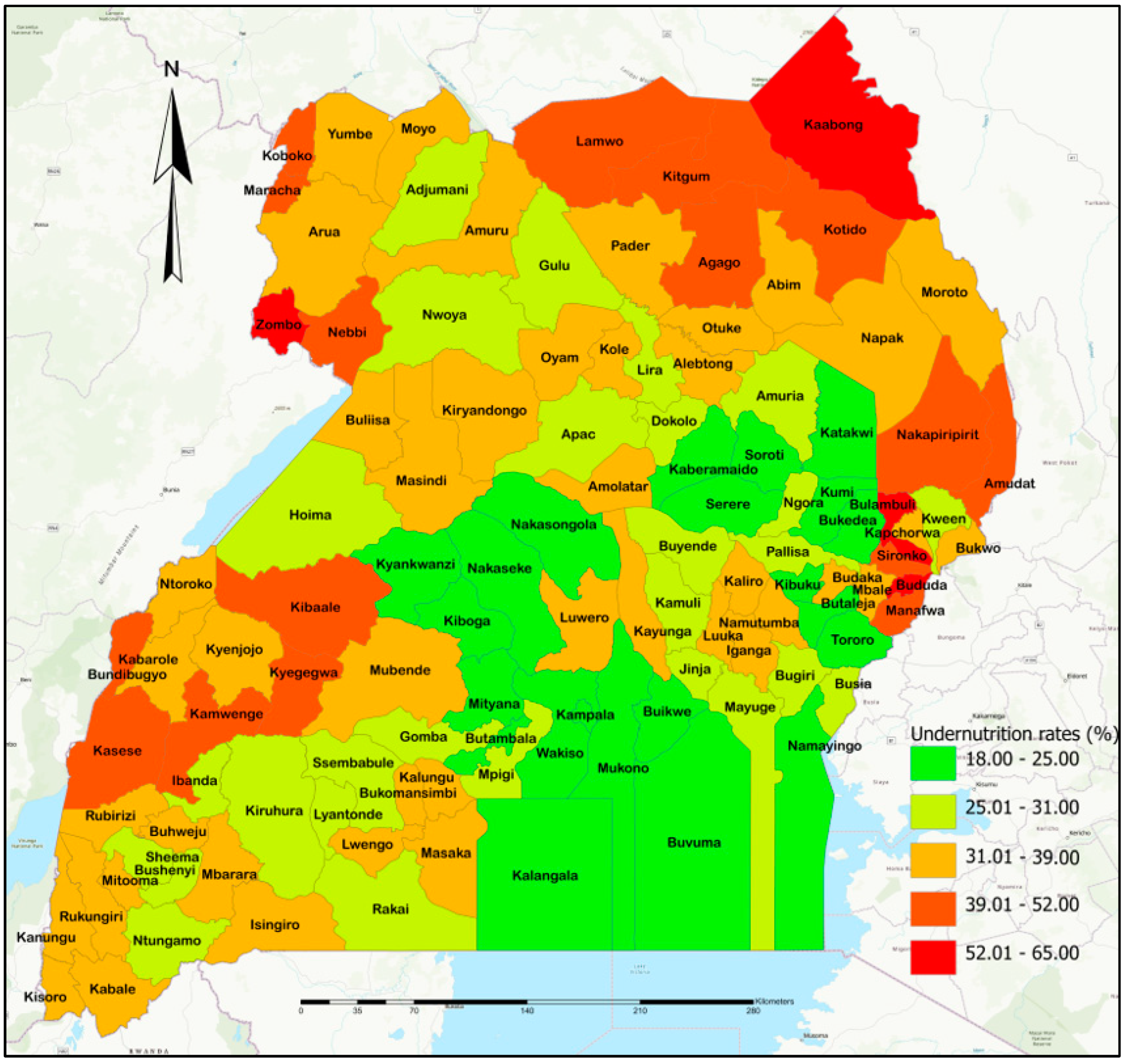

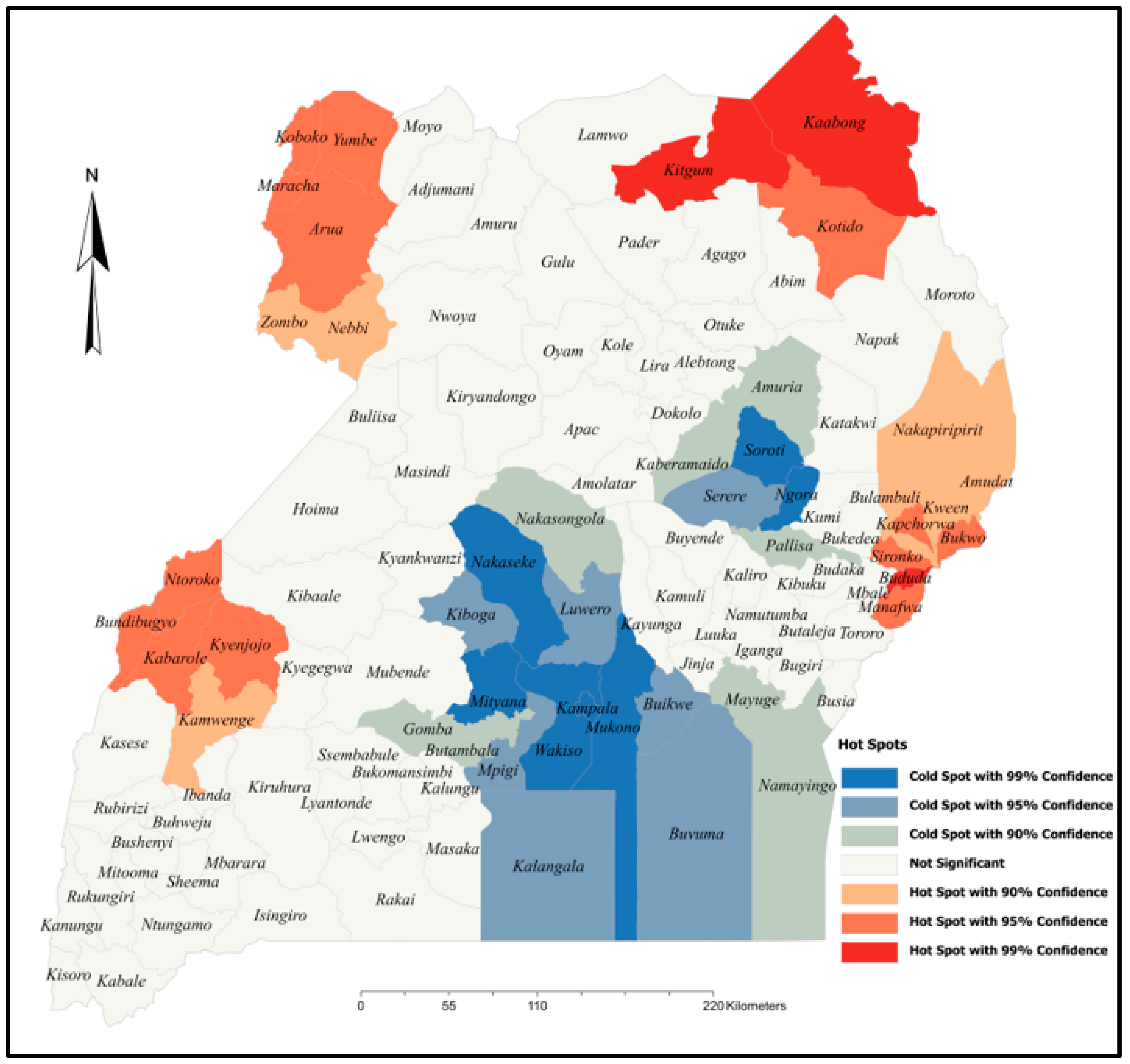
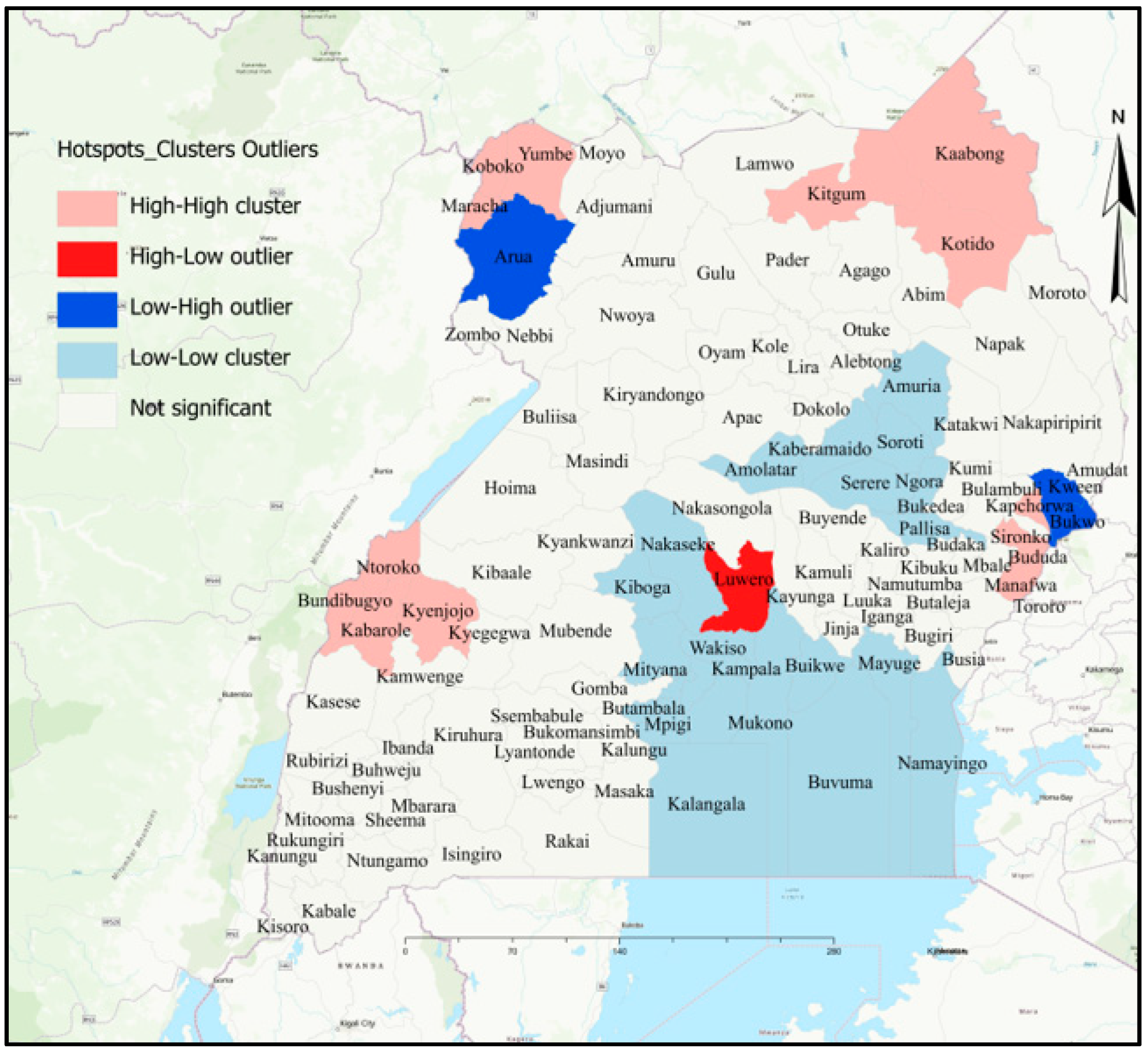
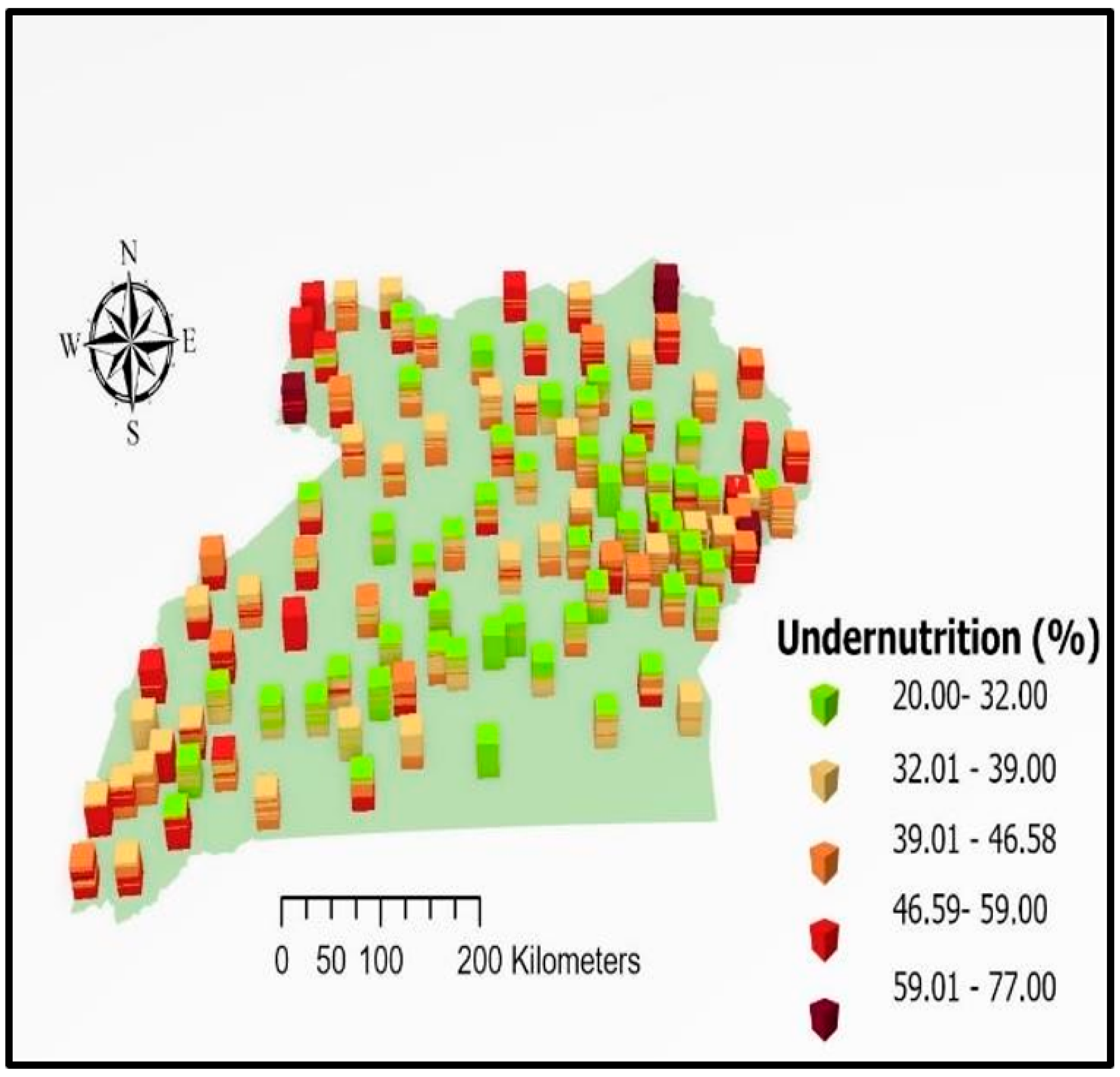
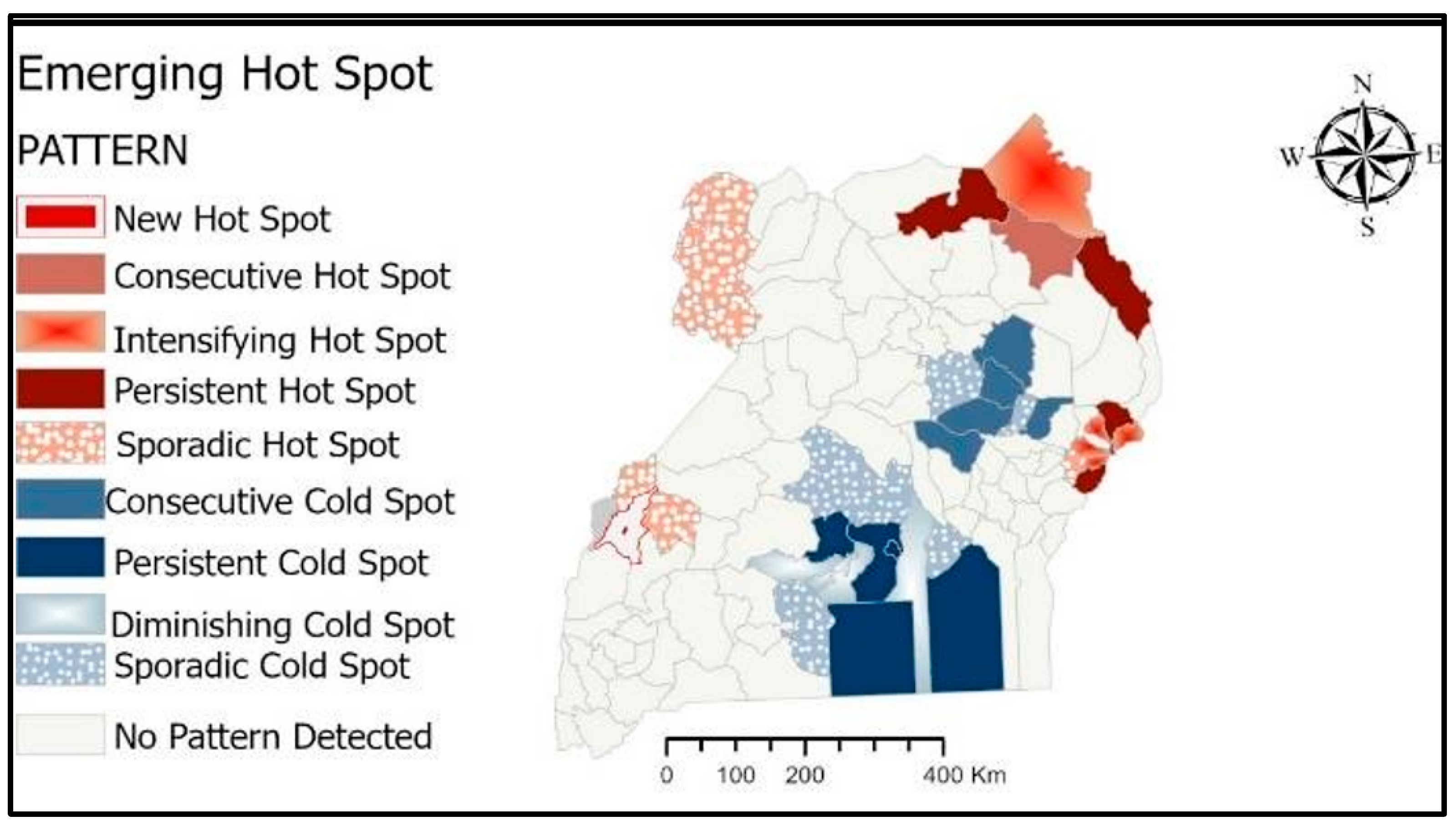

| Stunted | Underweight | Wasted | CIAF | Status |
|---|---|---|---|---|
| 1 | 1 | 1 | 3 | Undernourished |
| 1 | 1 | 0 | 2 | Undernourished |
| 1 | 1 | 0 | 2 | Undernourished |
| 0 | 0 | 1 | 1 | Undernourished |
| 0 | 0 | 1 | 1 | Undernourished |
| 0 | 0 | 0 | 0 | Normal |
| Undernutrition Status | ||
|---|---|---|
| Percentage of Children with at Least One Undernutrition Outcome | Ni | |
| Sex of the child | ||
| Male | 34.33 | 759 |
| Female | 29.55 | 644 |
| Total (N) | 31.96 | 4390 |
Disclaimer/Publisher’s Note: The statements, opinions and data contained in all publications are solely those of the individual author(s) and contributor(s) and not of MDPI and/or the editor(s). MDPI and/or the editor(s) disclaim responsibility for any injury to people or property resulting from any ideas, methods, instructions or products referred to in the content. |
© 2023 by the authors. Licensee MDPI, Basel, Switzerland. This article is an open access article distributed under the terms and conditions of the Creative Commons Attribution (CC BY) license (https://creativecommons.org/licenses/by/4.0/).
Share and Cite
Maniragaba, V.N.; Atuhaire, L.K.; Rutayisire, P.C. Analysis of Spatiotemporal Patterns of Undernutrition among Children below Five Years of Age in Uganda. Sustainability 2023, 15, 14872. https://doi.org/10.3390/su152014872
Maniragaba VN, Atuhaire LK, Rutayisire PC. Analysis of Spatiotemporal Patterns of Undernutrition among Children below Five Years of Age in Uganda. Sustainability. 2023; 15(20):14872. https://doi.org/10.3390/su152014872
Chicago/Turabian StyleManiragaba, Vallence Ngabo, Leonard K. Atuhaire, and Pierre Claver Rutayisire. 2023. "Analysis of Spatiotemporal Patterns of Undernutrition among Children below Five Years of Age in Uganda" Sustainability 15, no. 20: 14872. https://doi.org/10.3390/su152014872
APA StyleManiragaba, V. N., Atuhaire, L. K., & Rutayisire, P. C. (2023). Analysis of Spatiotemporal Patterns of Undernutrition among Children below Five Years of Age in Uganda. Sustainability, 15(20), 14872. https://doi.org/10.3390/su152014872





